Sensor Sweep: Gary Gygax Interview, Tarzan comics, August Derleth, Appendix N
Monday , 27, February 2023 Sensor Sweep Leave a commentRobert E. Howard (Paperback Warrior): “Robert E. Howard’s Iron Shadows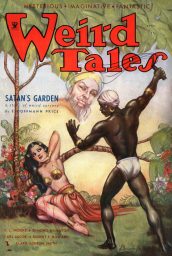 in the Moon”, starring Conan the Cimmerian, was published in Weird Tales in April, 1934. The story was renamed to “Shadows in the Moonlight, and appeared in the Gnome Press volume Conan the Barbarian in 1954. It was later edited by L. Sprague de Camp for inclusion in Swords & Sorcery, a 1963 collection published by Pyramid that featured authors like Fritz Leiber, H.P. Lovecraft, and Clark Ashton Smith.
in the Moon”, starring Conan the Cimmerian, was published in Weird Tales in April, 1934. The story was renamed to “Shadows in the Moonlight, and appeared in the Gnome Press volume Conan the Barbarian in 1954. It was later edited by L. Sprague de Camp for inclusion in Swords & Sorcery, a 1963 collection published by Pyramid that featured authors like Fritz Leiber, H.P. Lovecraft, and Clark Ashton Smith.
J.K. Rowling (Washington Examiner): Last year, Esquire magazine published a list of “The 50 Best Fantasy Books if All Time.” Harry Potter wasn’t on the list. Instead, sitting at the top was The Fifth Season by N.K. Jemisin, a work of fantasy with analogs to the real-life history of slavery on Earth that won the 2016 Hugo Award for Best Novel.
Firearms (Firearms News): I realized that the revolver I had seen come out of the vest pocket was a Safety Hammerless (aka Lemon Squeezer), but it took a while until I realized it was the scarce version with a two-inch barrel normally termed “Bicycle Revolver,” presumably because it could be tucked into a pocket while out peddling along. I also realized that the revolver that had made the impression on me was probably a .32 SW version is it could fit in a vest pocket. S&W also made .38 S&W Safety Hammerless revolvers, but they were bulkier.
of the vest pocket was a Safety Hammerless (aka Lemon Squeezer), but it took a while until I realized it was the scarce version with a two-inch barrel normally termed “Bicycle Revolver,” presumably because it could be tucked into a pocket while out peddling along. I also realized that the revolver that had made the impression on me was probably a .32 SW version is it could fit in a vest pocket. S&W also made .38 S&W Safety Hammerless revolvers, but they were bulkier.
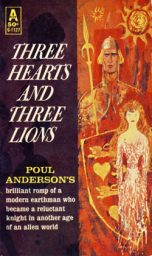 Appendix N (Grognardia): Poul Anderson’s 1961 novel, Three Hearts and Three Lions (originally released in two parts in the September and October 1953 issues of The Magazine of Science Fiction and Fantasy) is one of the most influential fantasy tales ever written, though I imagine very few fantasy fans under the age of 50 have read it. Michael Moorcock, for example, thought very highly of it, borrowing its conception of the eternal war of Law versus Chaos for his Elric stories, which in turn influenced countless other authors. Among those was Gary Gygax, whose conception of alignment in Dungeons & Dragons – itself a remarkably influential fantasy text – derives equally from Moorock and Anderson, hence the inclusion of both authors in Appendix N to his Dungeon Masters Guide.
Appendix N (Grognardia): Poul Anderson’s 1961 novel, Three Hearts and Three Lions (originally released in two parts in the September and October 1953 issues of The Magazine of Science Fiction and Fantasy) is one of the most influential fantasy tales ever written, though I imagine very few fantasy fans under the age of 50 have read it. Michael Moorcock, for example, thought very highly of it, borrowing its conception of the eternal war of Law versus Chaos for his Elric stories, which in turn influenced countless other authors. Among those was Gary Gygax, whose conception of alignment in Dungeons & Dragons – itself a remarkably influential fantasy text – derives equally from Moorock and Anderson, hence the inclusion of both authors in Appendix N to his Dungeon Masters Guide.
Weird Tales (Dark Worlds Quarterly): Yesterday was Weird Tales Day. The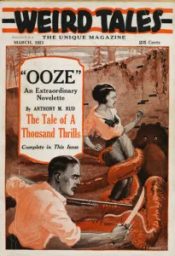 one hundredth anniversary of the first issue of Weird Tales hitting the newsstands. The first Pulp magazine dedicated to Horror, Science Fiction and the unusual. It predated Amazing Stories by three years. It launched the careers of seminal writers including H. P. Lovecraft, Robert E. Howard, August Derleth, Robert Bloch and so many others. Weird Tales was never a commercial runaway but was the epicenter from which American SF/F/H explodes. Without Weird Tales you don’t have the Cthulhu Mythos, Sword & Sorcery, Jules de Grandin and many other waves that flow from the 1920s.
one hundredth anniversary of the first issue of Weird Tales hitting the newsstands. The first Pulp magazine dedicated to Horror, Science Fiction and the unusual. It predated Amazing Stories by three years. It launched the careers of seminal writers including H. P. Lovecraft, Robert E. Howard, August Derleth, Robert Bloch and so many others. Weird Tales was never a commercial runaway but was the epicenter from which American SF/F/H explodes. Without Weird Tales you don’t have the Cthulhu Mythos, Sword & Sorcery, Jules de Grandin and many other waves that flow from the 1920s.
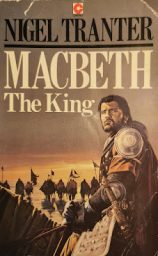 Fiction (Blog That Time Forgot): As part of my research, I revisited Nigel Tranter – in this case, Macbeth the King. For a work published in 1978, it’s amazing how few others have approached its quality. Here is a story which course-corrects the propaganda, using rigorous historical research as the basis for a new tale – one of a generous and conscientious king, a pragmatic and caring queen, bonds of brotherhood and familial betrayal, all against a backdrop of internecine conflict and cultural upheaval. And what a cracking read it is!
Fiction (Blog That Time Forgot): As part of my research, I revisited Nigel Tranter – in this case, Macbeth the King. For a work published in 1978, it’s amazing how few others have approached its quality. Here is a story which course-corrects the propaganda, using rigorous historical research as the basis for a new tale – one of a generous and conscientious king, a pragmatic and caring queen, bonds of brotherhood and familial betrayal, all against a backdrop of internecine conflict and cultural upheaval. And what a cracking read it is!
Edgar Rice Burroughs (Paperback Warrior): I really enjoyed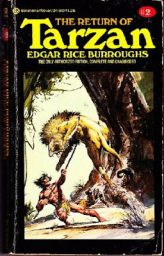 the Tarzan debut, Tarzan of the Apes, authored by Edgar Rice Burroughs. It was first published in 1912 in The All-Story and then later published as a novel in 1914. The book ended in what I would consider a cliff-hanger with a lot of loose ends requiring a resolution. The series second installment, The Return of Tarzan, does just that. It was first published in New Story Magazine from June through December of 1913. Later, it was published as a hardcover in 1915.
the Tarzan debut, Tarzan of the Apes, authored by Edgar Rice Burroughs. It was first published in 1912 in The All-Story and then later published as a novel in 1914. The book ended in what I would consider a cliff-hanger with a lot of loose ends requiring a resolution. The series second installment, The Return of Tarzan, does just that. It was first published in New Story Magazine from June through December of 1913. Later, it was published as a hardcover in 1915.
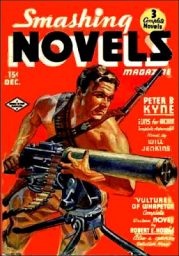 Robert E. Howard (Comics Old Time Radio): “The Vultures of Wahpeton,” a Western by Robert E. Howard, was first published in the December 1936 issue of Smashing Novels. It’s actually a novella, but it is pretty smashing. Wahpeton is a gold rush town. Many people have been getting rich, but an outlaw gang known as the Vultures keeps the town on lock-down, robbing claims and holding up every single stagecoach that attempts to transport gold out. The town and the surrounding area is crowded with men hoping to strike it rich, so no-one knows who is a Vulture and who isn’t.
Robert E. Howard (Comics Old Time Radio): “The Vultures of Wahpeton,” a Western by Robert E. Howard, was first published in the December 1936 issue of Smashing Novels. It’s actually a novella, but it is pretty smashing. Wahpeton is a gold rush town. Many people have been getting rich, but an outlaw gang known as the Vultures keeps the town on lock-down, robbing claims and holding up every single stagecoach that attempts to transport gold out. The town and the surrounding area is crowded with men hoping to strike it rich, so no-one knows who is a Vulture and who isn’t.
Forthcoming (Perusall): Two epics in one hardcover as Conan the mercenary faces hideously transformed wizards and undead creatures in action-packed fantasy combining Robert E. Howard’s trademark sword and sorcery with concepts straight out of Lovecraftian horror.
Combines the classic Conan and the Emerald Lotus with the all-new, original Conan and the Living Plague. The long-awaited follow-up to Conan and the Emerald Lotus brings John C. Hocking back to the sagas of the Cimmerian.
D&D (BBC Archive): This is an excerpt from a BBC archive program featuring Gary Gygax, founder of Dungeons and Dragons.
D&D (Splintered Realm): A Defense of Railroading If that isn’t a clickbaity blog post title, I don’t know what is. Them’s fightin’ words in these here parts. But hear me out. You can cancel me later (there’s plenty of time), but at least read a bit first. I LOVE the idea of sandbox gaming as a romantic notion. I love that I could have an entirely blank canvas to explore, and I’m limited only by the collective imagination of everyone at the table, hemmed in by a few loose frames that the rules might put in place.
D&D (Grumpy Wizard): The management of Wizards of the Coast decided to leave the OGL alone. In an attempt to repair the loss of trust, they put the 5.1 SRD into Creative Commons. That is a great outcome and I’m glad that they made that decision. I was wrong. I didn’t expect WotC to change their minds about the OGL.
Fiction (With Both Hands): The fire-side narrator quite naturally stops to tell you asides about the story, provides missing context, goes on tangents, and is very much a part of the performance. Over time, other kinds of storytelling developed this idea. The Greek chorus that so baffled me as a high school student is an obvious development of the role of the fire-side narrator, with the chorus providing you with missing context, reinforcing what is an appropriate moral reaction for the autists, and giving the playwright a distinctive voice.
Tolkien (Sacnoth’s Scriptorium): So, one more point Pratchett made, as recounted by his biographer, is the experience so many readers of Tolkien find in THE LORD OF THE RINGS not as an end in itself but as leading them on to other books and kind of books.
Gamergate (Arkhaven Comics): Gaming journalism is dead. It died last week. Gideon Litchfield, the Editor and Chief has thrown Wired’s credibility completely down the toilet. He has come forward defending Wired’s ludicrous 1/10 rated review of Hogwarts Legacy. There is no part of this review that isn’t laughably incompetent on every level. It fails at everything a review should try to do.
Review (DMR Books): A Feast of Ambrosia is a collection of stories about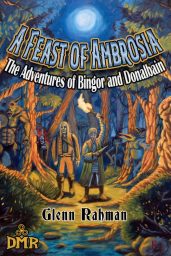 two mismatched adventurers, Donalbain and Bingor the Arab. Their stories take place in the Byzantine Empire around the year 1000 AD. At that time the Byzantine Empire was a mighty big place, including parts of what we now call Eastern Europe, parts of Africa and the Near East. More about the locales later, and how they help drive the stories.
two mismatched adventurers, Donalbain and Bingor the Arab. Their stories take place in the Byzantine Empire around the year 1000 AD. At that time the Byzantine Empire was a mighty big place, including parts of what we now call Eastern Europe, parts of Africa and the Near East. More about the locales later, and how they help drive the stories.
RPG (Walker’s Retreat): Now that we’ve talked about what the tabletop role-playing game is, as both a medium and a hobby, it is time to talk about it as a business. The business of tabletop RPGs is that of a toy business, and toys are a business of product pushing and brand identification. That seems to work, until you look closer at who sells what. Then reality starts asserting itself; the tabletop RPG medium is a Network Dependent Medium- the value of a RPG is wholly dependent on the size of the user network that plays it, and how tightly interconnected that network is.
Appendix N (Goodman Games): So you’re new to DCC RPG and you might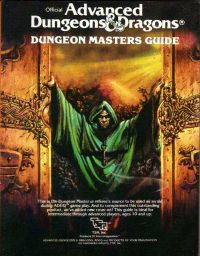 have heard that this game is heavily influenced by the Appendix N. Well what is the Appendix N? The quick answer is that it is the list of the books and authors that Gary Gygax, co-creator of D&D, said that we should check out for inspiration for our gaming. It has also become a point of fascination for those of us who want to better understand where D&D came from and what inspired different ideas and game mechanics.
have heard that this game is heavily influenced by the Appendix N. Well what is the Appendix N? The quick answer is that it is the list of the books and authors that Gary Gygax, co-creator of D&D, said that we should check out for inspiration for our gaming. It has also become a point of fascination for those of us who want to better understand where D&D came from and what inspired different ideas and game mechanics.
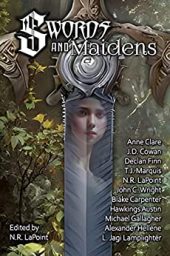 New (Wasteland & Sky): The first is the brand new Swords & Maidens anthology, stories about chivalry, love, and the wonder of romance. My story, “Judgement Sun” (which was once in the now OOP Planetary Sol anthology) is once again being made available for readers here! For those who haven’t read it, this tale is still one of my personal favorites that I wrote. This is a story about a desert planet on the brink of Armageddon.
New (Wasteland & Sky): The first is the brand new Swords & Maidens anthology, stories about chivalry, love, and the wonder of romance. My story, “Judgement Sun” (which was once in the now OOP Planetary Sol anthology) is once again being made available for readers here! For those who haven’t read it, this tale is still one of my personal favorites that I wrote. This is a story about a desert planet on the brink of Armageddon.
Fantasy (Karavansara): Two days back I finished a big translation job I was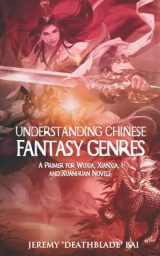 eager to get out of the way to clear my desk for the upcoming novel writing job I will be doing these next two months (more details soon). To celebrate the conclusion of the translation, I awarded myself an ebook, and got me a copy of Jeremy “Deathblade” Bai’s Understanding Chinese Fantasy Genres: A primer for wuxia, xianxia, and xuanhuan.
eager to get out of the way to clear my desk for the upcoming novel writing job I will be doing these next two months (more details soon). To celebrate the conclusion of the translation, I awarded myself an ebook, and got me a copy of Jeremy “Deathblade” Bai’s Understanding Chinese Fantasy Genres: A primer for wuxia, xianxia, and xuanhuan.
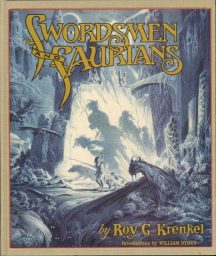 Artists (DMR Books): On this date in 1983, Roy G. Krenkel just…faded away. Admired and revered by the likes of Frank Frazetta, Al Williamson, Michael Wm. Kaluta and Bernie Wrightson, Roy’s death received little notice. It took some ardent fans years to discover that their idol had died.
Artists (DMR Books): On this date in 1983, Roy G. Krenkel just…faded away. Admired and revered by the likes of Frank Frazetta, Al Williamson, Michael Wm. Kaluta and Bernie Wrightson, Roy’s death received little notice. It took some ardent fans years to discover that their idol had died.
Science Fiction (Dark Worlds Quarterly):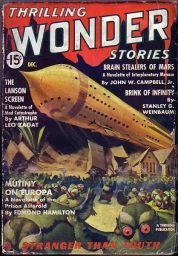 John W. Campbell gave us the aliens of Penton & Blake in a series of five stories. Campbell, who was the star of super-science fiction, did something a little different with this series. It wasn’t for Astounding but the more juvenile Thrilling Wonder Stories. Because of that, these tales are more adventure-oriented and, in my opinion, more fun than Campbell’s other stuff of the same time period. One of the things that make it more enjoyable are the weird creatures he conceives to inhabit his solar system.
John W. Campbell gave us the aliens of Penton & Blake in a series of five stories. Campbell, who was the star of super-science fiction, did something a little different with this series. It wasn’t for Astounding but the more juvenile Thrilling Wonder Stories. Because of that, these tales are more adventure-oriented and, in my opinion, more fun than Campbell’s other stuff of the same time period. One of the things that make it more enjoyable are the weird creatures he conceives to inhabit his solar system.
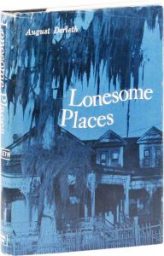 Authors (Goodman Games): Without August Derleth (1909-1971), you probably wouldn’t have that Cthulhu bumper sticker on your car, that Cthulhu for President poster, and certainly not that Plushie Cthulhu you have staring down at you from your geek-memorabilia shelf. Not that Cthulhu would not exist, but he (it?) would be just one more forgotten character in a series of stories by an author unknown except to the most ardent of horror literati. Howard Phillips Lovecraft’s greatest creation and most if not all of his fiction would have passed into obscurity if not for August Derleth’s founding of Arkham House publishing.
Authors (Goodman Games): Without August Derleth (1909-1971), you probably wouldn’t have that Cthulhu bumper sticker on your car, that Cthulhu for President poster, and certainly not that Plushie Cthulhu you have staring down at you from your geek-memorabilia shelf. Not that Cthulhu would not exist, but he (it?) would be just one more forgotten character in a series of stories by an author unknown except to the most ardent of horror literati. Howard Phillips Lovecraft’s greatest creation and most if not all of his fiction would have passed into obscurity if not for August Derleth’s founding of Arkham House publishing.
Horror Fiction (M Porcius): Let’s finish up the green 1963 paperback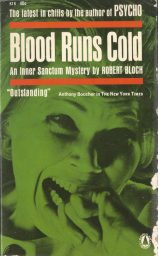 edition of Robert Bloch’s 1961 Inner Sanctum Mystery collection, Blood Runs Cold, that I recently purchased for five bucks at an antique mall in Hagerstown, Maryland that is full of genre fiction bargains. Only four stories remain for us to praise, denounce, or shrug at. At the end of this blog post we’ll count up the shrugs, curses and encomiums and provide a Blood Runs Cold Scorecard for all you TLDR and “Don’t Spoil Me!” types out there.
edition of Robert Bloch’s 1961 Inner Sanctum Mystery collection, Blood Runs Cold, that I recently purchased for five bucks at an antique mall in Hagerstown, Maryland that is full of genre fiction bargains. Only four stories remain for us to praise, denounce, or shrug at. At the end of this blog post we’ll count up the shrugs, curses and encomiums and provide a Blood Runs Cold Scorecard for all you TLDR and “Don’t Spoil Me!” types out there.
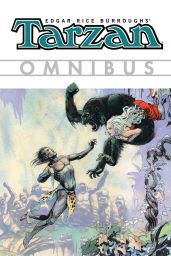 Comic Books (Pulp Super-Fan): During the time Dark Horse Comics had the Tarzan license, they put out several reprints and new comics with Tarzan. Some of these were crossover mini-series with other characters. But they also did a 20-issue comic with six storylines. Since then, this comic series was reprinted by Dark Horse as Edgar Rice Burroughs’s Tarzan Omnibus in 2015. It also includes the one-shot comic Tarzan: A Tale of Mugambi.
Comic Books (Pulp Super-Fan): During the time Dark Horse Comics had the Tarzan license, they put out several reprints and new comics with Tarzan. Some of these were crossover mini-series with other characters. But they also did a 20-issue comic with six storylines. Since then, this comic series was reprinted by Dark Horse as Edgar Rice Burroughs’s Tarzan Omnibus in 2015. It also includes the one-shot comic Tarzan: A Tale of Mugambi.
Crime Fiction (The Obelisk): Carroll John Daly (1889-1958) wrote about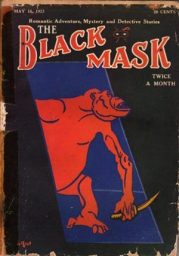 tough guys, but he certainly did not look like one. Slender, with a trimmed mustache and owl-eyed spectacles, Daly grew up in Yonkers, New York. Educated at De la Salle Institute and the American Academy of Dramatic Arts, Daly became a professional writer in the early 1920s. “The False Burton Combs” was one of his earliest tales, being published by Black Mask in December 1922. “The False Burton Combs” is a crime caper about a private eye who assumes the identity of a wealthy playboy during a Nantucket vacation.
tough guys, but he certainly did not look like one. Slender, with a trimmed mustache and owl-eyed spectacles, Daly grew up in Yonkers, New York. Educated at De la Salle Institute and the American Academy of Dramatic Arts, Daly became a professional writer in the early 1920s. “The False Burton Combs” was one of his earliest tales, being published by Black Mask in December 1922. “The False Burton Combs” is a crime caper about a private eye who assumes the identity of a wealthy playboy during a Nantucket vacation.
Please give us your valuable comment